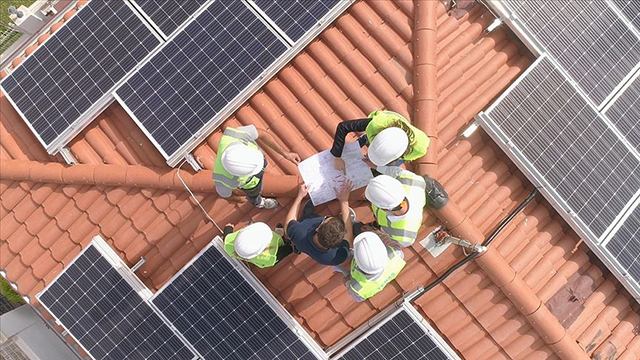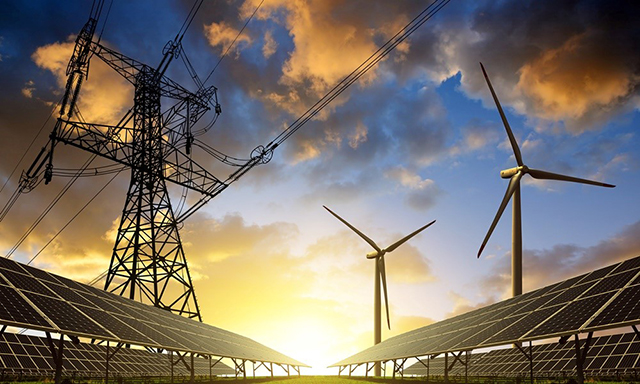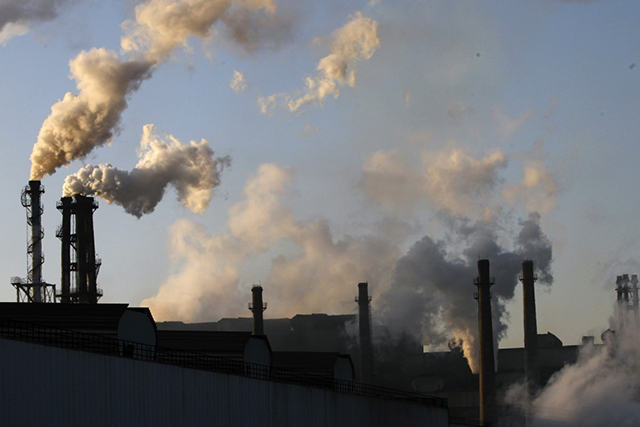
Turkey will soon announce details on small-scale Energy Resource Areas (YEKA) bidding, with the first tenders scheduled for the first quarter of 2020, Energy and Natural Resources Minister Fatih Donmez said Monday.
Speaking at the annual meeting of Turkey’s Electric Industry Union (TESAB), Donmez said the country has undergone a huge transformation in the last 18 years, including in the development of renewable energy sources.
“With these YEKA bids, we are moving toward a sector with a high participation rate,” he said.
The YEKA projects, each capable of generating between 10 to 40 megawatts (MW) of power, will be installed in close to 40 provinces across Turkey.
Turkey has been working on reducing its dependence on energy imports and increasing production from natural resources.
The authorities put YEKA sites as the basis of Turkey’s clean energy drive, increasing domestic production and strengthening local electricity generation capacity.
Turkey plans to boost its wind and solar capacity by 10,000 MW each year over the coming decade through YEKA.
"The country’s total power generation, which was at 31,000 MW in 2002, has tripled in just 18 years, reaching over 91,000 MW," Donmez said while crediting domestic sources and renewable energy as the backbones of this increase.
"Today, over 60% of our power comes from domestic and renewable energy sources. Nearly 62% of our electricity generation was made through renewable energy sources between January and October of 2019," he said.
Donmez further stressed that in terms of electricity production, power transmission and commercialization, Turkey has become a leader.
Thanks to a competitive and quality-based sector, with the involvement of private industry, the country’s electricity market is now on par with global standards, Donmez said.
TESAB itself has become the leader in public-private cooperation, he added.
Turkey held the first 1,000 MW solar power YEKA tender in March 2017. A consortium of Turkish Kalyon and South Korean Hanwha Group was awarded the contract for the $1.3-billion project in the central Anatolian city of Konya. The feed-in-tariff at the auction was set at $6.99 per kilowatt-hour (kWh).
The first 1,000 MW wind power YEKA contract was awarded to the Turkish-German consortium consisting of Kalyon-Turkerler-Siemens. The feed-in-tariff was set at $3.48 per kWh, recorded as the lowest for similar projects around the world.
Source: Daily Sabah

Rooftop solar energy is projected to see an approximate 66% jump in capacity to 1,250 megawatts (MW) by the end of the year, according to the head of the Turkish section of Solar Energy Society, GUNDER, Kutay Kaleli on Wednesday.
Speaking at the Solar Istanbul – Solar Energy, Storage, E-Mobility and Digitalization Exhibition & Conference in the Istanbul Congress Center Kaleli said Turkey's solar sector has seen tremendous growth over the past years with almost a 100-fold growth between 2015 and 2020.
Revised legislation introduced by Turkish Energy Market Regulatory Authority's (EMRA) in May 2019 saw the more seamless installation of solar panels with greater installed capacities – of up to a maximum of 10 kilowatts for the residential sector and up to 5 megawatts for the industrial sector.
The installed capacity in solar energy reached more than 6,000 megawatts (MW) in Turkey thanks to the decrease in investment costs, Kaleli explained.
Since the opening of the rooftop solar market in Turkey in 2019, the number of applications reached more than 2,000 with an installed capacity of more than 750 MW. Turkey's solar energy sector is going through a transformation in which large solar installations are no longer desirable, and the trend now has moved to more numerous smaller installations.
"There is no longer 7-10 MW of large investments in solar sector and now there are many 200 or 500 kilowatts or a few 2 to 5 MW of roof top solar systems. So we can say that our sector is transforming towards a retail sector rather than a wholesale sector," he said.
Kaleli lauded rooftop solar energy as having many advantages, the most prominent being energy supply security due to its ability to produce power anywhere in a distributed form.
"Solar plants can make a big contribution to supply security for any country," he asserted.
The second biggest advantage is in employment opportunities. Currently, there are 60,000 employed in the renewables sector in Turkey, according to Kaleli.
"The increase in smaller installations and roof top solar plants means that the number of local Engineering, Procurement, Construction (EPC) firms will rise and add to the employment numbers. I believe 60,000 employees might scale up to 80,000 in just a year," he said. Kaleli advised that energy costs would fall with the introduction of smaller solar plants, which have proved successful in recouping their set-up costs.
"We expect that the number of small plants will exceed 1,250 MW with installation completed by the year-end," Kaleli said.
- Clarification needed after YEKDEM expires
Turkey's Solar Energy Investors Association (GUYAD) Secretary General Berke Aygun explained that Turkey is similar to other countries in that governments worldwide make 70% of their country's investment decisions.
Based on this statistic, Aygun said she is awaiting clarification of what will happen when Turkey’s Renewable Energy Support Scheme (YEKDEM) expires at the end of the year.
"We expect a new regulation governing unlicensed plants under 1 MW of capacity after YEKDEM. These plants constitute 5,500 MW capacity in total," she explained.
Turkey, which wants to fully utilize local and renewable energy sources efficiently to support its development, offers feed-in tariffs for renewable energy plants such as wind, hydropower, geothermal, biomass and solar through the YEKDEM scheme.
Renewable energy plants under the scheme are granted incentives depending on the type of renewable energy used.
The scheme, which started in 2011, supports wind and hydropower plants at a cost of $0.073 per kilowatt-hour (kWh), geothermal facilities at $0.105 kWh, and solar and biomass plants at $0.133 kWh. These figures can also vary slightly depending on the use of locally-produced equipment.
The head of the Turkish Solar Energy Industry Association, GENSED, Halil Demirdag, hailed Turkey’s advancement in solar deployment and greater manufacturing capacity and trade to neighboring countries, including Ukraine and Bulgaria.
Solar Istanbul, which Anadolu Agency is a global communication partner, is running from March 11 to 13 in the Istanbul Congress Center where leading companies from the solar sector are showcasing their products to key buyers.
Source: AA

Bosnia’s autonomous Serb Republic aims to add 1,000 megawatts (MW) of renewable energy sources by 2029 at a cost of 11.5 billion Bosnian marka ($6.7 billion) to smooth its transition from coal, its energy minister said.
The largest portion of projects, targeting solar, wind and hydro sources, will be carried out by the majority state-run power utility ERS, Petar Djokic said.
“We are aware of what the reality is in our neighbourhood and of European Union demands... and we must tap unused renewable energy potential to reduce our carbon footprint,” he told an energy forum in the southeastern Bosnian town of Trebinje.
ERS General Manager Luka Petrovic told Reuters that 20% of the projects’ value would be funded by ERS’ equity and the remainder through loans.
ERS operates two coal-fired power plants with a combined capacity of 600 MW and three big and several small hydropower plants with a total capacity of 617 MW.
To secure the funding, but also to put ERS on a solid footing, the utility has kicked off restructuring process which includes redundancies that will cut the workforce by the end of 2020 to 8,600 from the current 9,500.
“The total workforce will be reduced by 20 percent in the coming period,” Petrovic said. He added that additional savings would be made through the separation of generation, distribution and supply businesses by 2021.
“We will start operating at market terms as of next year, when small consumers will be able to choose their preferred supplier,” he said. The region has already opened up markets for industry and small businesses.
Petrovic added that electricity prices, which are 30% lower in Bosnia than in the rest of the Western Balkans, would also have to be de-regulated and increased to achieve these goals.
He said that ERS Holding posted a small profit in 2019 due to three-month maintenance of one of its coal-fired plants and an outage at Croatia’s 252-MW Dubrovnik hydro power plant, which supplies part of its power output to ERS, forcing ERS to import power to make up for the shortfall.
Source: Reuters

A new research paper ‘The promise of seasonal storage’ finds that the price of seasonal storage, if based on compressed hydrogen, could become cost-competitive with alternative forms of long-term storage.
The research conducted by DNV GL explores the viability of balancing yearly cycles in energy demand and renewable energy generation with long-term storage technology.
The research is based on a case study modeling energy generation and demand for 58 different climate years.
The need for additional storage solutions is lower than expected and can be largely covered with available short-term storage technology such as battery storage systems.
The growing number of electric vehicles in our transport system will provide most of the needed short-term energy storage to balance renewable energy in the power grid.
The rise of synthetic fuels can provide a critical stepping-stone for the use of seasonal storage applications. Synthetic fuels enable CO₂ heavy sectors to be decarbonized by creating hydrogen from low-priced (renewable-generated) electricity, which is then converted into e-fuels like ammonia. For the use case investigated, the long-term storage of electricity would become economically viable, especially in markets like Germany, where a vast amount of low-carbon electricity will be available in the coming decades.
The price of seasonal storage, if based on compressed hydrogen, could become cost-competitive with alternative forms of long-term storage such as burning gas due to the growing incentivization of low-carbon technology. This price development is based on the expected increase of the carbon price from $25 to $60 per tonne CO₂ by 2050 in Europe, according to DNV GL’s Energy Transition Outlook Report.
As energy demand is increasingly electrified, for example through rising numbers of electric vehicles and in buildings, for space heating and cooling, this growing demand is largely being met by variable renewables, which increases the need for long-term storage solutions.
The price of seasonal storage, if based on compressed hydrogen, could become cost-competitive with alternative forms of long-term storage such as burning gas due to the growing incentivization of low-carbon technology.
This price development is based on the expected increase of the carbon price from $25 to $60 per tonne CO₂ by 2050 in Europe.
Source: Smart Energy International

Emissions from coal power saw the 'biggest fall' in decades last year as electricity generation switched toward solar and wind, a report has found.
The global study by climate think tank Ember found that electricity generation from coal fell 3 per cent in 2019 — leading to a 2 per cent reduction in carbon emissions.
This is the biggest decrease on both counts since the International Energy Agency began reporting on them in the year 1990.
However, declining coal generation is not yet 'the new normal' — and more will be needed in the coming years to meet climate targets, the Ember report concluded.
The analysis was based on data on 2019 electricity generation that covered 85 per cent of the world — including China, the EU, India and the United States.
Limiting global warming to 1.5°C above pre-industrial levels — which scientists warn is necessary to avoid the worst impacts of climate change — will be extremely difficult, Ember said.
While coal power usage has collapsed in both the EU and the US, the use of electricity sourced from the fossil fuel grew in contrast in China last year, with the country now responsible for half of the world's coal generation, the report found.
The fall in coal usage is partly due to a structural shift towards wind and solar but also one-off factors, such as the restarting of nuclear power generation in Japan.
However, coal use would need to collapse at a rate of at least 11 per cent each year until 2030 to keep global warming down to 1.5°C or less, the report warned.
The reduction in coal use in the US which fell by 16 per cent in 2019 is undermined in terms of its climate impact by the fact that the power sector has undergone a significant switch over to gas.
In the EU, coal generation fell by 24 per cent, with the bloc leapfrogging from coal straight to wind and solar power, the report noted.
Wind and solar generation rose by 15 per cent in 2019, generating 8 per cent of the world’s electricity.
This level of growth will need to continue for many years in order to tackle the climate crisis a feat possible with falling prices, but one that will require a concerted effort from all regions, the report warned.
The researchers' analysis also revealed that the growth in demand for electricity has slowed down to 1.4 per cent the smallest increase since the 2009 recession due to a combination of low economic growth and a milder winter in the EU and the US.
Source: Daily Mail Online

Some countries are likely to wait and see whether U.S. President Donald Trump wins another four years in office in November before committing to stepping up their climate ambitions at this year's UN climate conference, according to Alden Meyer, director of strategy and policy for the Union of Concerned Scientists (UCS).
“Everyone knew in 2015 it was the expectation – even though we were not able to get a kind of ‘shall’-language in there – that countries would update their original Paris pledges by 2020,” he told Clean Energy Wire.
While a number of smaller countries have already done so, most of the G20 countries have not.
If big players like the European Union and China give a joint signal at the upcoming leaders' summit in Leipzig this September, it would be “a huge deal” and would help move countries like India and others, Meyer said.
“But with the U.S. on the sidelines and unless you have the EU and China leadership, I think it is quite likely that people are going to be waiting to see what the U.S. election outcome in November is before deciding where to go on their Paris commitments.”
Under the 2015 Paris climate agreement, countries around the world are expected to increase their nationally determined contributions (NDCs) as part of a global drive for more ambition this year, and the EU and Germany are expected to play a pivotal role.
After the UN climate conference in Madrid left many disappointed, countries are set to ratchet up ambitions in the run-up to the next UN climate conference in Glasgow in November.
The EU-China summit in Leipzig in September could be an opportunity for the two regions to announce more ambitious policies – a much needed push as oil-rich Saudi Arabia hosts the G20 summit and the United States may well cement its farewell to the Paris Agreement with a re-election of President Donald Trump.
Source: Clean Energy Wire
Electricity Storage Valuation Framework
Electricity storage could be a crucial factor in the world’s transition to sustainable energy systems based on renewable sources. Yet electricity markets frequently fail to account properly for the system value of storage.
This report from the International Renewable Energy Agency (IRENA) proposes a five-phase method to assess the value of storage and create viable investment conditions. IRENA’s Electricity Storage Valuation Framework (ESVF) aims to guide storage deployment for the effective integration of solar and wind power.
Please click here to read the full report.

